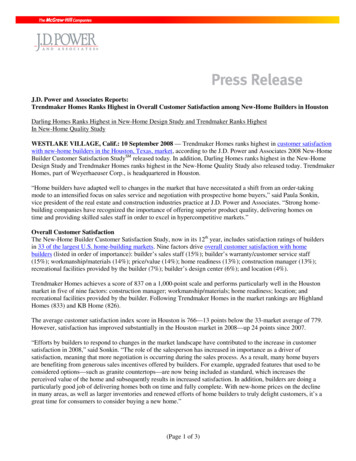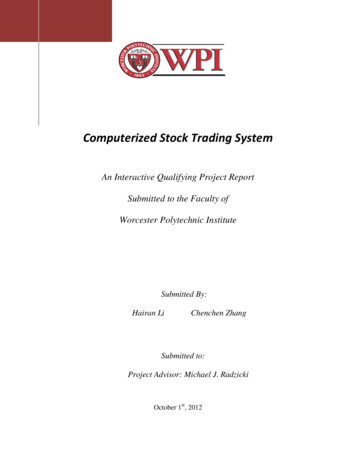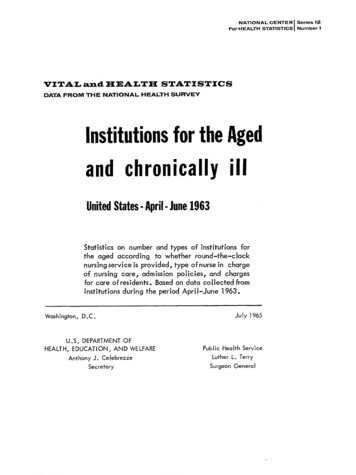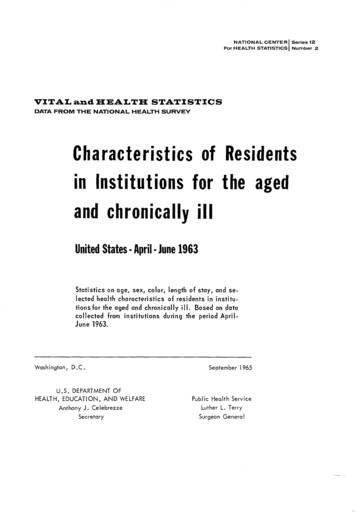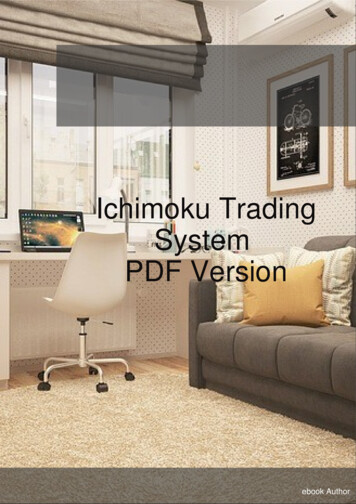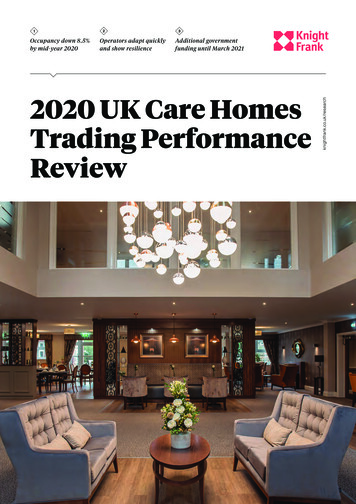
Transcription
Operators adapt quicklyand show resilienceAdditional governmentfunding until March 20212020 UK Care HomesTrading cy down 8.5%by mid-year 2020
CARE HOMES TRADING PERFORMANCE 2020CARE HOMES TRADING PERFORMANCE 2020INTRODUCTIONFIG 1 Regional spread of 2020 surveyFIG 2 Regional share – Knight Frank survey vsTotal UK stockKnight Frank surveyTotal UK market20%SCOTLANDNursing care homePersonal care home2020 has been a year like no other, and especially so for theUK care home sector which has adapted immensely well to achallenging operating KS & THEHUMBER5%regional split of this year's sample mostly mirrors the totalthank you this year to all the operators that have helped toUK market. The only clear exception being Wales, where ourkeep the survey sample as robust as ever.sample is slightly underweight.As you can see from Figure 1, our survey includes careSOUTHEASTSource: Knight FrankSource: Knight FrankWalesmeasure the impact of Covid-19 across the sector. A specialLONDONSOUTHWESTNorthern Irelandincluding dementia care. Figure 2 also shows how theNorth Eastonwards when the pandemic emerged. This has allowed us to0%East Midlandsowned homes registered to deliver full-time nursing care,EAST OFENGLANDLondonbut also any changes in performance that occurred from AprilWALESScotlandweighting towards the corporate market, with most group-South Westindustry-leading benchmarks for the 2019/20 financial year,EASTMIDLANDSWESTMIDLANDSWest Midlandspersonal (residential) care homes. This reflects the survey’sYorks &The HumberTrading Performance Index to incorporate the usualNorth Westaccount for two-thirds of the sample, versus one-third forEast of Englandhis year, we have adapted our annual Care HomeSouth EastT15%Source: Knight Frank, Tomorrow's Guideshomes spread far and wide across the UK. Nursing care homesFIG 32020 RESULTS AT A GLANCETHESURVEY INNUMBERSof the corporategroup market1/4Care bedsof UK carehome market67Countiesand islanddependencies2FINANCIAL YEAR2019/20112k819UK townsand citiesQ2 202071%OCCUPANCYAVERAGE WEEKLYFEESSTAFF COSTS(% OF INCOME)EBITDARM(% OF INCOME)87.9%89.2%87.4% 889 766 95358.0%55.1%59.0%26.8%28.5%26.3%All CarePersonalNursingAll CarePersonalNursingAll CarePersonalNursingAll CarePersonalNursing79.4%Occupancy declines by 8.5%between March and June, butrecovers 1.2% by October 2020(more on pages 4 and 5) 93861.3%Fees increase for theCOVID-19 adds to staffingfurther 5.6% is showing in theSocial Care Infection Control(more on pages 6 and 7)(more on pages 8 and 9)challenges, but the Adult10th consecutive year and aFund provides a buffer.2020/21 financial year.326.2%Limited impact on profitabilitythus far in the pandemic, buta challenging period ahead.(more on pages 10 and 11)
CARE HOMES TRADING PERFORMANCE 2020CARE HOMES TRADING PERFORMANCE 2020Tracking the pandemicFIG 6 Occupancy changes during Q2 2020Following the outbreak of Covid-19 intracking shows an estimated recovery of 1.2%now in place among large group operators,March there was a clear concern for carein the third quarter as death rates normalisedwho report being in a much strongeroperators regarding the direct threat ofand operators have begun to confidently admitposition than in March. As of the end ofthe virus to residents and staff, but alsonew residents. There remain concerns over aOctober, we had not seen a meaningfulconcern surrounding the tracking andsecond wave, but rigid testing procedures areincrease in care home fatalities.FIG 7 Average occupancy by region, 2019/20financial year vs Q2 20202019/20 FYGAIN20% Q2 2020UK: 2019/20 FYUK: Q2 2020100%10% to 20%monitoring of the situation. Since then,90%0% to 10%FIG 4 UK care home occupancy rateoperators to provide an objective weeklyCovid-19OUTBREAK87.9%occupancy levels across the market andNo change80%0% to .2%collected provides a timely indication of87.7%Trading Performance Survey, the data88.9%89.3%is separate from the annual Care Home88.8%measure of occupancy levels. While this80.6%we have been working with many major70%10% to 20%will serve to track the pace of recovery inmonths to come.20% to 30%OCCUPANCY5%10%15% 22MarSource: ONS, General Register ay31May07JunSouth WestEast MidlandsSouth Eastchange in occupancy or even madeflu and diseases such as dementia anddirectly and indirectly resulted in overgains over the summer. This sectionAlzheimer’s, but Covid-19 has been an30,000 excess deaths across the UK careof the survey has excluded homes thatunprecedented challenge.home sector.received block bookings from the NHS,What has this meant foroccupancy rates?and therefore any gains reflect usualbusiness. Figure 6 also shows that of thehomes that lost occupancy in Q2 2020,fatality rates of 15-20% for those overAs shown in Figure 4, the uptickmost lost between 0% and 10%. In manythe age of 80, and higher for those within mortality produced an 8.5%cases, declines were less than 5%.multiple health conditions. The rapiddecline in occupancy across thedischarge of vulnerable elderly peopleUK. Encouragingly, mortality ratesfrom NHS hospitals and into care homesnormalised by early June and weNo region of the UK has been shelteredalso posed an additional challenge.have since seen a steady rise in newfrom the virus, although occupancyadmissions, helping to stabilisehas generally dropped lower inretrospectively assess the impactoccupancy levels. Pent up demandmore densely populated and urbanof the outbreak on the care homeis expected to support a recoveryregions. This has been the case insector. ONS data, compiled from thein occupancy, but stringent testingLondon and the East Midlands whereGeneral Register Office, shows thatprocedures for new residents and someoccupancy has slipped to 75-76%.from 1st March to 7th June there werehesitancy among enquiring relativesDensely populated regions have seenapproximately 29,178 excess deathsmay soften the pace of recovery.more severe outbreaks, but greaterOver six months on, we can5,000Yorks &The Humbersurveyed have experienced either noperiod ¹, suggesting that Covid-19 hasacademic studies were suggesting caseAll deaths 2019Londonrecorded in Scottish care homes in thisdeal with outbreaks of seasonalloss seemed justified in March, whenFIG 5 Care home deaths registered in England & WalesSource: Knight Frankajor operators are equipped toFears of substantial occupancyCovid-19 deaths35%Percentage of surveyed care homesSource: Knight FrankDespite the challenges, the data shows how resilient major careproviders have been over the summer periodAll other deaths in 202025% 30%West Midlands0%East of EnglandSouth WestSource: Knight FrankNorth WestSource: Knight Frankof 2020. However, our additional weeklyNorth East30% Walesrespondents during the second quarterLOS SScotland60%Q32006 2007 2008 2009 2010 2011 2012 2013 2014 2015 2016 2017 2018 2019 Q2/11/12/13/14/15/16/17/18/19 /20 2020 2020/07 /08 /09 /10fell by 8.5% across our main surveyNorthern IrelandFigure 4 shows how occupancy(over and above 2019 levels) across careThere are varying stories acrossRegional comparisondemand for care beds could facilitate ahomes in England and Wales (Figure 5).providers and individual homes. Asswifter recovery in occupancy as newClose to 2,000 Covid-19 deaths were alsoshown in Figure 6, 28% of homesadmissions return.5
CARE HOMES TRADING PERFORMANCE 2020CARE HOMES TRADING PERFORMANCE 2020FEES ANDFUNDING OF CAREFIG 9 Average weekly fees, by region and caretype 2019/20NurisingPersonalFIG 10 Funding split by regionPrivate-pay (self-funded)UK Avg PersonalUK Avg NursingNHS fundedLA fundedOther funding 1,200100% 1,100 1,00080% 900 8005.5% 7004.9%5.9%60%3.9%5.5%40% 600 50020% 400 300Source: Knight FrankLAUKNorthern IrelandLondonP R I V AT E - P AYNorth EastScotlandWalesNorth WestEast of EnglandYorks &The HumberWest MidlandsSouth WestSouth EastP E R S O N AL C AR EEast MidlandsN U R S I N G C AR ENorth EastNorthern IrelandYorks &The HumberNorth WestScotlandEast MidlandsWalesWest MidlandsSouth WestAL L C AR EEast of EnglandLondonSouth East2019/20 saw care home fees increase across our index by a further 6% year-on-year,averaging 889 per week across all care types.0%Source: Knight FrankSource: Knight FrankRegion: As shown in Figure 9, there isless dramatic in real terms whensignificant variation in fee levels acrossadjusted for inflation. As shown inregions and more granular localitiesFigure 8, care home fees have increasedwithin the UK. Fee levels in Southern50% in nominal terms since 2008/09,England tend to be higher than thebut inflation-adjusted growth amountsNorth of England, matching the higherto only 8% over the same period.staff costs seen in the South. In theOperators continue to adjustwere seen across all regions of the UK,of increasing costs, in particularexcept Wales, where average fees for thestaffing costs. Furthermore, withpersonal care segment held flat at 650much of the care home real estateper week.market older than twenty years, extrarevenue is increasingly needed to fundrefurbishments and upgrades. We expectthis trend to continue going forward asmany existing homes will need to adaptthe design and layout of their facilitiesas a legacy of the pandemic.What determines fee levels?Care type: The average weekly fee fora nursing home in the UK in this year'sindex was 953, compared to 766 perweek for personal care homes. Thepremium is due to the level of careprovided, with nursing homes typicallydesigned for higher-dependencyresidents requiring full-time medicalcare delivered by qualified nurses.Further fee uplifts haveoccurred in the newfinancial year, recordedfrom April to June 20202019/20 financial year, fee increasesfees to counterbalance a numberFunding type: The majority of carehomes derive their funding from acombination of local authorities andprivate-paying residents (self-funded).FU NDI NG TY PEC AR E T Y P EFIG 8 UK Average weeklyfee growthFee uplifts in the 2020/21 financial year (preliminary)This year we are also able to reportfunding types. Homes in our sample that areis making its way into the residential carepreliminary data on changes in fee levelsprimarily funded by local authorities have seensector. It is not yet clear if these risesin the new financial year. As shown ina 5.5% rise in fees in Q2 2020, suggestingwill be permanent or temporary, with theFigure 11, further fee uplifts have beenthat some of the additional 3.2 billion fundinggovernment yet to finalise a long-termunanimous across both care types andsupplied to local authorities by the governmentsolution to the care funding crisis.FIG 11 Average weekly fee uplifts for 2020/21 financial year (Q2 2020)NominalReal Terms (less RPI inflation) 1,000As you can see from Figure 10, the split5.6%varies significantly across regions. Inthe North East and London, a significant4.9%5.9%4.0%5.5%P R I V AT E - P AYLA 800amount of residents qualify for fulllocal authority support, or at least partfunding. In contrast, more affluent areasAL L C AR E 600P E R S O N AL C AR EN U R S I N G C AR Elike the South East and South West ofEngland derive more of their incomefrom private-paying residents. Averageweekly fee rates in the UK private-paymarket measured 1,086 in 2019/20,compared to 746 a week for localauthority funded fees.6 152015/162016/172017/182018/192019/20Steeper rises in recent years lookFU NDI NG TY PEC AR E T Y P ESource: Knight FrankSource: Knight Frank7
CARE HOMES TRADING PERFORMANCE 2020COSTSAs operators look to support their workforcesduring the pandemic, increasing staff costs remaina significant challengeStaffingFollowing the trend in recent years, staffcosts across the index increased 3.7%FIG 12 Average wage rates, per hour2018/19CARE HOMES TRADING PERFORMANCE 2020per registered bed per annum. Weoutbreak and this could turn a relativelyacross the UK. Our index shows somesuspect certain property costs to jumpsmall outlay into a larger one unlessnoteworthy variation across countriesin the new financial year as a result ofmore support is given to operators. Foodin the UK with food costs in ScotlandCovid-19. Soaring indemnity insurancecosts also increased by 3.1%, measuring( 1,489 per bed) close to 10% lower thanpremiums have been reported since theon average 1,629 per occupied bedfood costs in England ( 1,646 per bed).TABLE 1 Staff costs, agency costs and resident to staff ratios 2019/20STA FF C O STS, PE RRE SIDE N T P. A .Y E A R- ON -Y E A RCHA N G ESTA FF C O STS, %OF IN C OM EAG E N CY C O STS, %OF STA FF C O STSRESI DENT: STAFF(RATI O*)Nursing Care 29,3224.0%59.0%9.9%0.85Personal Care 21,3514.1%55.1%6.2%0.58All care 26,9563.9%58.0%9.0%0.76Source: Knight Frank *Includes all nurses and carers. Part-time staff calculated as half a staff member2019/20to an average of 26,956 per residentper annum for the 2019/20 financialyear. Further increases to the National 16.90Living Wage (NLW) have contributed toAdditional costs prompt Adult Social Care Infection Control Fundthis, especially for personal care homes.For those over the age of 25, the NLWThe most obvious additional costthat operators spent as much as 61.3% ofMay, the fund will inject a much neededresulting from the pandemic is that ofincome on staffing in the second quarter 1.15 billion to support infection controlpersonal protective equipment (PPE)2.of 2020 (Figure 13). This partly reflects aand related staffing and recruitment costs.As a percentage of income, staffTo gauge the extent of these costs wereduction in income, but is also down toLocal authorities must ensure that 80%costs represented 58.0% of incomeasked operators to detail spending onincreasing staffing costs.of the grant goes directly towards carein the 2019/20 financial year and arePPE before and during the pandemic.especially high in the nursing careWhile noting significant variation acrossmay be contained by the Adult Social Careprivate homes. This will certainly provide asector. There are a number of reasons foroperators, our analysis shows thatInfection Control Fund. Introduced on the 13thlifeline for many homes.this. Pay scales are significantly higheroperators spent an average of 160increased by 4.9% in April 2019 followedby a further increase of 6.2% in AprilNURSE2020, to reach 8.72 per hour. 16.04for skilled nurses, with the hourly rateper bed per annum on PPE during theFIG 13 Staff costs as % of income, since 2009/09almost double that of a carer (Figure 12);2019/20 financial year, compared toWorkforces are larger – our index shows 260 per bed during the second quarter62%that for every nursing home resident,of 2020 alone. While these numbers61%may seem small, PPE will represent a60%significant extra cost to operators59%the appropriate level of care (Table 1);over the course of the pandemic and58%Finally, nursing homes are more heavilyeven beyond.57%there are approximately 0.85 full-timenurses or carers employed to ensure 8.75reliant on agency staff, whose use alwaysCARERcosts a premium (Table 1).Property and food costsProperty costs (which we define 8.33as utilities, council tax, insurance,56%55%high staff costs. Many care homes have54%had to remunerate and support existing53%the same time recruiting new staff to fillgaps in the workforce. Our survey showsrepairs and day to day maintenance)increased by 3.7% across the UK inAs well as PPE, irregular spendingon staffing will have added to existingstaff during periods of isolation, while at2008 2009 2010/09/10/11Source: Knight FrankSource: Knight Frank2019/20, reaching on average 2,3998homes within their geography, includingAny further escalation of staff 17/182018/192019 2020/20Q2
CARE HOMES TRADING PERFORMANCE 2020CARE HOMES TRADING PERFORMANCE 2020PROFITABILITYadditional funds provided via the AdultFIG 16 EBITDARM as % of income, by region and care type 2019/20Social Care Infection Control Fund mayonly partially show up in our mid-yearNursingnumbers, but will be a vital cushionPersonalUK Avg: PersonalUK Avg: Nursing35%against the additional cost of thepandemic for many care homes.30%The challenge of Covid-19 is byno means over, but operators have25%demonstrated an ability to limit theCare operators have demonstrated an ability to limit thehuman and financial impact of the virus so far20%human and financial impact of thevirus so far and are in a strong position15%as we approach winter. Going underthe radar are the broader long-term10%issues of the funding crisis in careand Brexit, the latter of which serves5%to reduce the pool of migrant carersmarket. As illustrated by Figure 15, aare weighing on margins in the nursinghas been on a downward trajectorythird of group-owned care homes tradedcare segment of the market, which isover the last decade. The 2019/20at EBITDARM margins in excess of 30%challenged to deliver 24/7 nursing carefinancial year was no different within 2019/20, while only 5% made a loss.to residents. The South East, London,average EBITDARM margins decliningIn most regions, profit margins areWalesNorthernIrelandLondonScotlandSouth EastNorth WestSouth Westprofile of these issues.Yorks &The HumberAs shown in Figure 14, profitabilityEast ofEnglandof the pandemic will be to raise theWest MidlandsEast Midlandsdesperately needed. Hopefully a legacyNorth East0%and nurses at a time when they areSource: Knight FrankSource: Knight FrankWales and Scotland are the onlyto 26.8%. Despite the broad story, therehigher across the personal care sector,exceptions to this trend. A largeris a huge amount of variation within theas shown in Figure 16. High staff costsprivate-pay market, supported byFIG 17 EBITDARM margins, 2019/20 financial year vs Q2 2020higher fees, has helped to raiseprofitability in the South East, whileFIG 14 EBITDARM as % ofincome, since 2008/09FIG 15 Distribution ofEBITDARM margins, 2019/2033%32%40% or more30%-40%20%-30%10%-20%0%-10%31%Loss makingoccupancy rates well in excess of 90%are supporting earnings in the Scottishand Welsh nursing segments.2019/20 FY26.8%Q2 ummarising the financialimpact of Covid-19As shown in Figure 17, EBITDARMmargins have seen little decline so30%far, falling by only 0.6% in the second11%29%5%11%quarter of 2020. Limited declines arealso consistent across care types and28%21%27%22%funding models. A lot of this mustbe credited to care operators and thesocial care workforce who have ralliedto protect residents, support the26%wider healthcare system, and made25%2008/092009/102010/1 1201 1/122012 /132013/142014 nt personal sacrifices inAL L CAR EP ER S O N AL CAR EP R IV AT E- P AYLASource: Knight Frankthe process.Fee uplifts in the new financial yearCAR E T Y P Eand additional government supportSource: Knight FrankN U R S IN G CAR Ehave also helped to support tradingSource: Knight FrankF U N DI N G T Y P ESource: Knight Frankperformance across the sector. The1011
FORWARD VIEWJulian Evans FRICSHead of HealthcareThis year’s trading performancesurvey has made two things evenclearer to me. Firstly, this crisis hasdemonstrated the resilience andcapability of our residential carecontinue to champion the incredibleis something we certainly recogniseperformance of care home operatorsas advisors, but the willingness ofand their workforces during themany providers to contribute in ourpandemic. While the British mediasurveys confirms that you do too. I’dhas at times conveyed a hystericallike to thank all the operators thatimage of care homes, an occupancyhave once again submitted theirloss of only 8.5% across a sector thatdata for the purposes of our annualdeals in caring for the most vulnerableTrading Performance Review. Indemographic in society is an incredibleparticular, I would like to thank thosefeat, and testament to operators.operators that have participated inLooking forward, group operators areour weekly occupancy and mortalitynow in a much stronger position, andtracking since March 2020. Thanksfor a whole host of reasons.to you, our datasets have providedsector. Undoubtedly, the pandemicSecondly, the crisis has demonstratedhas tested and will continue tothe huge importance of reliable, real-test operators financially well intotime data across the broader healthcarenext year, but it’s critical that wesector and within residential care. Thisvaluable intelligence to the marketin 2020 and creating better and moreusable healthcare data will form a keypart of our strategy for 2021.Please get in touch with usFront Cover: Graysford Hall, Leicester, SandersSenior LivingFootnotes:(1) 1,973 Covid-19 deaths were registered with the NationalRecords of Scotland (NRC) between 22nd March and 27thSeptember 2020.(2) Our survey is based on PHE definition of PPE, includingdisposable gloves, fluid-repellent masks, and eye protection.Please note additional costs may have been incurred throughthe purchase of cleaning products, hand sanitiser and tempera-HealthcareSenior LivingJulian Evans FRICSTom ScaifeHead of HealthcareHead of Senior Living 44 20 7861 1147 44 20 7861 rank.comPatrick Evans MRICSCommercial ResearchHead of Corporate ValuationsJoe Brame 44 20 7861 1757Senior Analyst (Healthcare)patrick.evans@knightfrank.com 44 20 3967 7139ture checking arch 2020Why is investmentinterest growing?New development andre-development will be essential6 key trendsdriving the marketCase studies: Germany,France & SpainEuropeanHealthcareElderly Care Market, Research 2020Knight Frank ResearchReports are available Upgrading the market hasnever been more importantHealthcare DevelopmentOpportunitiesC-19 only a short-termdisrupter to constructionEuropean Healthcare ReportRecent Publicationsjoe.brame@knightfrank.comKieren Cole MRICSHead of Commercial Valuations 44 20 7861 1563kieren.cole@knightfrank.comKnight Frank Research provides strategic advice, consultancy services and forecasting to a wide rangeof clients worldwide including developers, investors, funding organisations, corporate institutions andthe public sector. All our clients recognise the need for expert independent advice customised to theirspecific needs. Important Notice: Knight Frank LLP 2020 This report is published for general informationonly and not to be relied upon in any way. Although high standards have been used in the preparationof the information, analysis, views and projections presented in this report, no responsibility or liabilitywhatsoever can be accepted by Knight Frank LLP for any loss or damage resultant from any use of, relianceon or reference to the contents of this document. As a general report, this material does not necessarilyrepresent the view of Knight Frank LLP in relation to particular properties or projects. Reproduction of thisreport in whole or in part is not allowed without prior written approval of Knight Frank LLP to the form andcontent within which it appears. Knight Frank LLP is a limited liability partnership registered in England withregistered number OC305934. Our registered office is 55 Baker Street, London, W1U 8AN, where you maylook at a list of members’ names.
CARE HOMES TRADING PERFORMANCE CARE HOMES TRADING PERFORMANCE 4 5 Following the outbreak of Covid-19 in March there was a clear concern for care operators regarding the direct threat of the virus to residents and staff, but also concern surrounding the tracking and monitoring of the si
